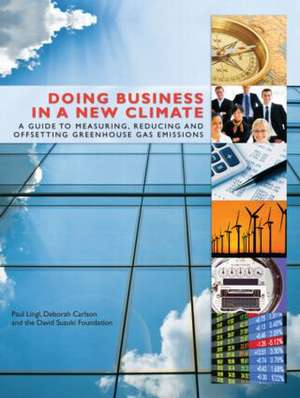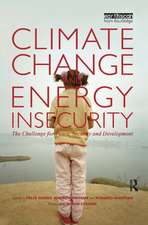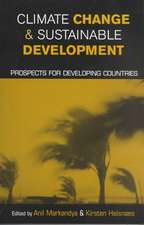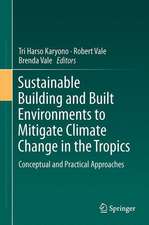Doing Business in a New Climate: A Guide to Measuring, Reducing and Offsetting Greenhouse Gas Emissions
Autor Paul Lingl, Deborah Carlson, The David Suzuki Foundationen Limba Engleză Paperback – 29 ian 2010
| Toate formatele și edițiile | Preț | Express |
|---|---|---|
| Paperback (1) | 295.74 lei 6-8 săpt. | |
| Taylor & Francis – 29 ian 2010 | 295.74 lei 6-8 săpt. | |
| Hardback (1) | 820.40 lei 6-8 săpt. | |
| Taylor & Francis – 29 ian 2010 | 820.40 lei 6-8 săpt. |
Preț: 295.74 lei
Preț vechi: 339.65 lei
-13% Nou
Puncte Express: 444
Preț estimativ în valută:
56.60€ • 61.46$ • 47.54£
56.60€ • 61.46$ • 47.54£
Carte tipărită la comandă
Livrare economică 23 aprilie-07 mai
Preluare comenzi: 021 569.72.76
Specificații
ISBN-13: 9781844079087
ISBN-10: 1844079082
Pagini: 96
Ilustrații: Full colour, photographs, figures, graphs, boxes
Dimensiuni: 203 x 254 x 5 mm
Greutate: 0.27 kg
Ediția:1
Editura: Taylor & Francis
Colecția Routledge
Locul publicării:Oxford, United Kingdom
ISBN-10: 1844079082
Pagini: 96
Ilustrații: Full colour, photographs, figures, graphs, boxes
Dimensiuni: 203 x 254 x 5 mm
Greutate: 0.27 kg
Ediția:1
Editura: Taylor & Francis
Colecția Routledge
Locul publicării:Oxford, United Kingdom
Public țintă
Professional Practice & DevelopmentCuprins
Introduction Climate Change Impacts on the EconomyPart I: Getting Started: Planning for the Success of the GHG Management Program Define the Business Case Establish Goals Obtain Buy-In and Commitment Create a Climate Leadership Team and Allocate Funds Helpful ResourcesPart II: Measuring Greenhouse Gas Emissions Why Carry Out an Emissions Inventory? The Greenhouse Gas Protocol Setting BoundariesCollecting Activity Data Calculating GHG Emissions Quality Control Helpful ResourcesPart III: Reducing Greenhouse Gas Emissions Reduction Targets Identifying Reduction Opportunities Selecting Reduction Measures Tracking Reductions and Cost Savings Examples of GHG EmissionReduction Opportunities Helpful ResourcesPart IV: Offsetting Greenhouse Gas Emissions and Going Carbon Neutral What Is Carbon Neutral? Making a Decision to Go Carbon Neutral Benefits of Carbon Neutral Initiatives Risks Developing an Effective Carbon Neutral Initiative Different Types of Carbon Neutral Initiatives What Is a Carbon Offset? High Quality Carbon Offsets Deciding Which Offsets to Purchase Helpful ResourcesPart V: Communicating Effectively: Supporting the GHG Management Program Developing an Effective Communications Plan Principles of Good Communications for Environmental Initiatives Tailoring Messages to Different AudiencesHelpful ResourcesPart VI: Moving Forward and Overcoming Challenges Time and Money Too Many Options A Steep Learning Curve for the Emissions InventoryLack of Internal Expertise Motivating Employees Integration of GHG Management into Decision-Making Ongoing Monitoring and Adjustment Helpful ResourcesConclusion Additional ResourcesGlossaryEndnotes
Notă biografică
The David Suzuki Foundation is committed to protecting the diversity of nature and our quality of life, now and for the future.Paul Lingl has been developing climate change solutions at the David Suzuki Foundation since 2001, and has advised businesses, governments, and major event organizers. He has also worked for a number of leading green businesses in Canada.Deborah Carlson has worked at the David Suzuki Foundation since 2006 developing greenhouse gas management strategies for businesses and other organizations. Previously she practiced law in Vancouver and Geneva. Lingl and Carlson have also co-authored Meeting the Challenge, A Carbon Neutral 2010 Winter Games Discussion Paper, which was commissioned by the organizers of the 2010 Vancouver Olympics.























